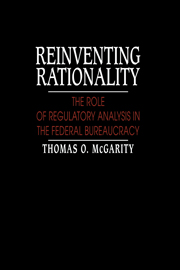Book contents
- Frontmatter
- Contents
- Acknowledgments
- Abbreviations
- Introduction
- Part I The clash of regulatory cultures
- Part II Regulatory analysis in theory and practice
- 3 Getting the lead out of gasoline: EPA's lead phasedown regulations
- 4 Getting the dust out of the air: EPA's ambient air quality standard for particulate matter
- 5 Getting obstructions out of the driver's view: NHTSA's field of direct view regulations
- 6 Getting the bone out of processed meat: FSIS's mechanically separated meat standard
- 7 Getting information into hazardous workplaces: OSHA's hazard identification regulations
- 8 The virtues of regulatory analysis
- 9 Limitations of regulatory analysis
- 10 Regulatory analysis in the real world
- Part III Structuring regulatory analysis into the decisionmaking process
- Part IV Review of regulatory analysis
- Part V Conclusions
- Notes
- Bibliography
- Index
6 - Getting the bone out of processed meat: FSIS's mechanically separated meat standard
Published online by Cambridge University Press: 16 October 2009
- Frontmatter
- Contents
- Acknowledgments
- Abbreviations
- Introduction
- Part I The clash of regulatory cultures
- Part II Regulatory analysis in theory and practice
- 3 Getting the lead out of gasoline: EPA's lead phasedown regulations
- 4 Getting the dust out of the air: EPA's ambient air quality standard for particulate matter
- 5 Getting obstructions out of the driver's view: NHTSA's field of direct view regulations
- 6 Getting the bone out of processed meat: FSIS's mechanically separated meat standard
- 7 Getting information into hazardous workplaces: OSHA's hazard identification regulations
- 8 The virtues of regulatory analysis
- 9 Limitations of regulatory analysis
- 10 Regulatory analysis in the real world
- Part III Structuring regulatory analysis into the decisionmaking process
- Part IV Review of regulatory analysis
- Part V Conclusions
- Notes
- Bibliography
- Index
Summary
Modern food processing technology has passed the corner butcher by. The human butcher, however careful, inevitably leaves some edible tissue on the bone. Mechanical processes can break up the parts of the carcass remaining after hand deboning, grind them up, and force them at very high pressure through a small aperture to produce a pasty product that can be used in meat spreads, lunchmeat, and sausages. While this process maximizes the amount of edible tissue, it is impossible to keep very fine bone particles out of the final product. Mechanically separated meat (MSM) also differs from hand deboned meat in that it has a highly comminuted spreadable consistency, contains bone marrow and other minerals not common to hand deboned meat, and contains more fat and less protein than hand separated meat. Because MSM can be substituted for hand deboned meat in many products, without detection by most consumers, marketing MSM as “meat” or “meat product” might run afoul of consumer expectations.
Although the consumer protection aspect of MSM might by itself justify regulatory intervention, MSM also raises a health concern. The additional calcium in MSM due to pulverized bone can be quite harmful to a small population of “calcium hyperabsorbers” who take up calcium at a much higher rate than the normal population. Because this sensitive subpopulation must monitor the calcium content of food very carefully, regulatory intervention may be necessary to limit the amount of calcium in food containing MSM or to ensure that calcium hyperabsorbers can easily avoid such products. Finally, MSM's slightly higher fluoride content poses some risk of contributing to mottled teeth in children.
- Type
- Chapter
- Information
- Reinventing RationalityThe Role of Regulatory Analysis in the Federal Bureaucracy, pp. 73 - 88Publisher: Cambridge University PressPrint publication year: 1991



